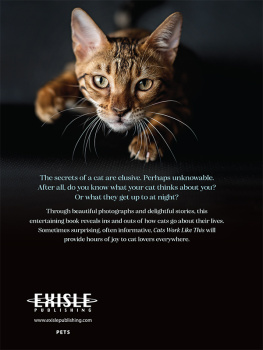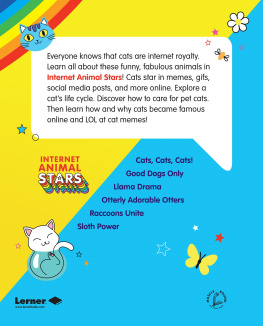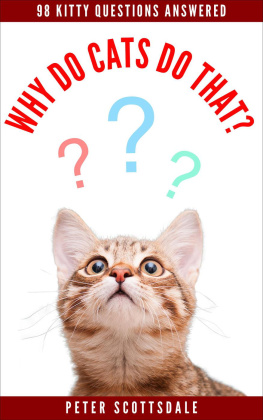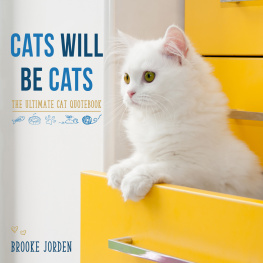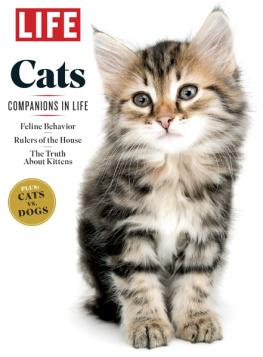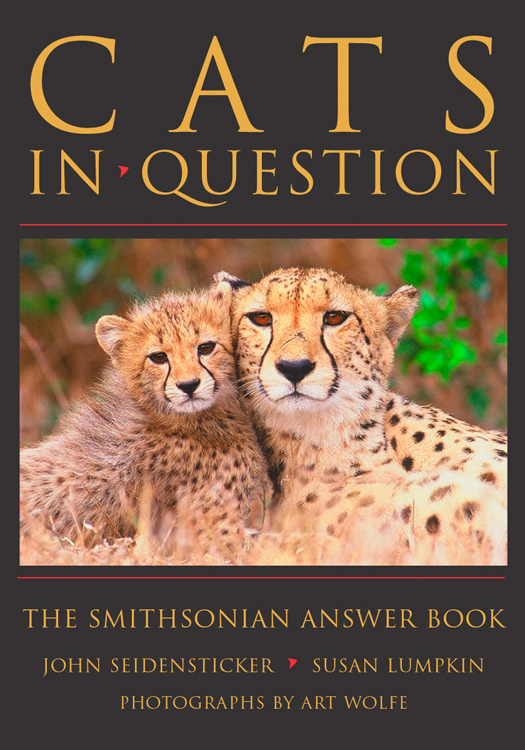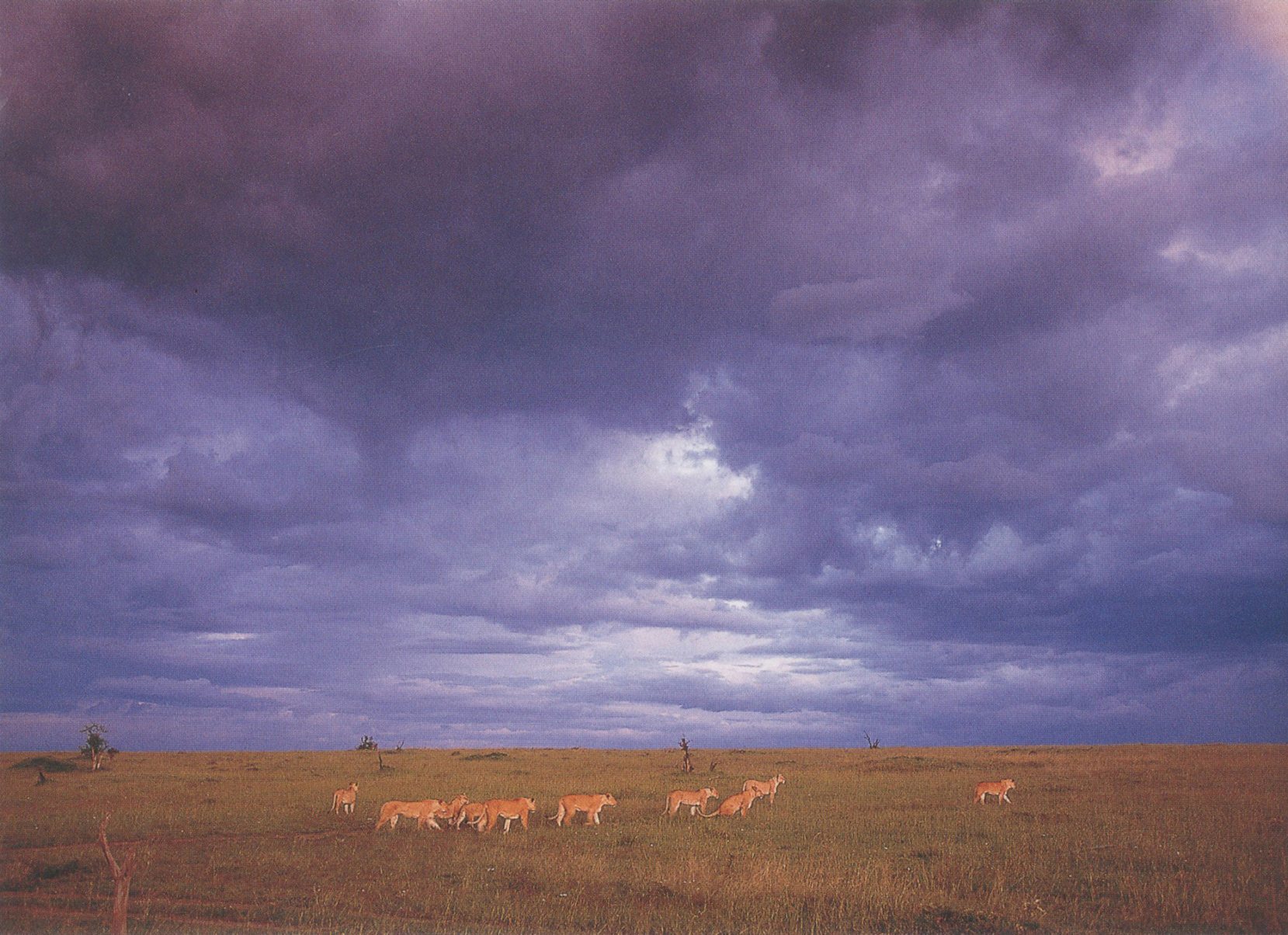2004 by John Seidensticker and Susan Lumpkin
Photographs 2004 by Art Wolfe
Copy editor: Robin Whitaker
Production editor: Joanne Reams
Designer: Janice Wheeler
Library of Congress Cataloging-in-Publication data:
Seidensticker, John.
Cats in Question / John Seidensticker and Susan Lumpkin; photographs by Art Wolfe.
p. cm.
Includes bibliographical references and index.
ISBN 1-58834-125-9 (alk. paper)ISBN 1-58834-126-7 (pbk.: alk. paper)
1. FelidaeMiscellanea. I. Lumpkin, Susan. II. Smithsonian Books (Publisher). III. Title.
QL737.C23S4252 2004
599.75dc22
2004041671
eBook ISBN: 978-1-58834-546-2
British Library Cataloging-in-Publication data available
For permission to reproduce photographs appearing in this publication, please correspond directly with the owner of the work, as listed in the individual caption. Uncredited photographs are by Art Wolfe. Smithsonian Books does not retain reproduction rights for these illustrations individually or maintain a file of addresses for photographic sources.
Frontispiece: Requiring huge expanses of African plains habitat to survive, lions face an uncertain future on that crowded continent. Human activities are squeezing out most other cat species too. Greater awareness of the danger cats face is the first step toward our securing their future in the wild.
v3.1
CONTENTS
.1.
CAT FACTS
.2.
CAT EVOLUTION AND DIVERSITY
.3.
CATS AND HUMANS
PREFACE
From the vantage point of our garden patio each summer night, we watch a half dozen or so domestic cats, some feral, some with collars, slowly patrol our alley just off Fourteenth Street in northwest Washington, DC. Some walk by a few minutes apart. Now and then, two will stroll by together. Many usually pause briefly at the gate and check if we are sitting out or not. Our garden pond with its goldfish and our garden birds are a big attraction when we are not around. We have been fascinated with cats, watching them for our professional careers and even before that, but we are reminded each evening of Niko Tinbergens lament in The Herring Gulls World: Even an hours careful observation of the goings-on in a gullery faces one with a great number of problemsmore problems, as a matter of fact, than one could hope to solve in a lifetime (Tinbergen 1970, xiv). So it is with cats.
People love cats, or respect them, or loathe them, or are terrified of them, depending on cat and circumstance. Cats have been used as a model biological system to help us better understand disease, morphology, physiology, and behavior in various other species. We have studied cats neuro-function to better understand how animals perceive the world. Biologists have teased apart the social lives of cats to help us better understand complex cooperative and competitive strategies. How the presence or absence of different wild cat species alters the composition of local ecological communities and the patterns of biological diversity across broad geographical ranges is the focus of a growing number of biological reports. We are learning how human-caused stresses on ecological communities result in the decline of populations of most species of wild cats. We sense that, as a result of this scientific activity, the awe, fear, and mystery that once surrounded wild cats are rapidly being replaced with appreciation. Our e-mail indicates that people have increasing numbers of questions about cats in general and about living with cats. We wrote this book to enable people to look at cats more closely, ask questions, and find accurate answers to their questions so that they can better enjoy and appreciate cats.
This book is arranged like the others in the Smithsonian Answer Book series. We start with Cat Facts, a chapter that answers questions about cat biology, physical features, senses, diet and predation, social behavior, and cat life. lists some Web sites that offer more information about cats. The references include both general works on cats and specialized scientific references on individual topics. Art Wolfes spectacular photographs bring even the rarest cats up close. Please note that wherever John is mentioned in the book, this refers to John Seidensticker, one of the two coauthors.
ACKNOWLEDGMENTS
We prefer our cats wild. Our positions at the Smithsonians National Zoological Park and Friends of the National Zoo have allowed an unbroken and unparalleled opportunity to watch wild cats every day and to travel frequently to see and study wild cats where they live in the wild. This has been a splendid place from which we can share our passion for cats through our writing, exhibits, and lectures. Peter Cannell, late director of Smithsonian Institution Press, asked us to write this Smithsonian Answer Book. Vincent Burke encouraged and supported us while we were deeply involved in other projects. Nicole Sloan and Caroline Newman of Smithsonian Books saw the project to completion. Robin Whitakers copy editing was masterful and much appreciated. Alvin Hutchinson tracked down dozens of papers and books in short order. Thank you.
We are especially grateful for the support John has received over the years from Friends of the National Zoo, Smithsonians National Zoological Park, Smithsonian Special Foreign Currency Fund, World Wildlife FundUS, World Wide Fund for Nature, ExxonMobil Foundation, National Fish and Wildlife Foundation, and Save The Tiger Fund and the generous hospitality of Estacin Biolgica de Doana. This allowed John to visit and study cats where they live in the eastern deciduous forest and intermontane West of the United States, the Russian Far East, the mountains of central China, Thailand, Bangladesh, Nepal, India, Sri Lanka, Kenya, Spain, Yucatn in Mexico, and Sumatra, Java, and Bali in Indonesia. We thank our friends and colleagues who have shared their thoughts about cats with us over the years; they include Ted Bailey, Warren Brockleman, Kathy Carlstead, Ravi Chellam, Raghu Chundawat, John Eisenberg, Louise Emmons, Lyn DeAlwise, Eric Dinerstein, Nestor Fernandez, Joe Fox, Al Gardner, Josh Ginsburg, John Gittleman, Helmut Hemmer, Rafael Hoogesteijn, Maurice Hornocker, Peter Jackson, Rod Jackson, A. J. T. Johnsingh, Warren Johnson, Ullas Karanth, Kae Kawanishi, Devra Kleiman, Margaret Kinnaird, Gary Koehler, Boonsong Lekagul, Paul Leyhausen, Chuck McDougal, Jeff McNeely, Jill Mellen, Hemanta Mishra, Sriyanie Miththapala, Fumi Mizutani, Dale Miquelle, Tim OBrien, Steve OBrien, Gustav Peters, Pat Quillen, Howard Quigley, Alan Rabinowitz, Douglas Richardson, George Schaller, Dave Smith, Alan Shoemaker, Mel and Fiona Sunquist, Ir. Suyono, Blaire Van Valkenburgh, Wang Sung, Wang Zong-Yi, Stuart Wells, Chris Wemmer, Wilber Wiles, and Eric Wikramanayake. Many others, wherever we have been and worked, have generously shared observations. This book is much better for their contributions. Any errors, of course, are ours.
The Smithsonians mission, the increase and diffusion of knowledge, is as exhilarating as it is challenging. A wise editor taught us that the first step is writing so that someone who cares will read and understand what you write. We wrote this book for our daughter, Lesley Seidensticker, and for our parents and their memoryTom and Mary Lou Lumpkin and John and Gladys Seidensticker. This book is dedicated to them.


